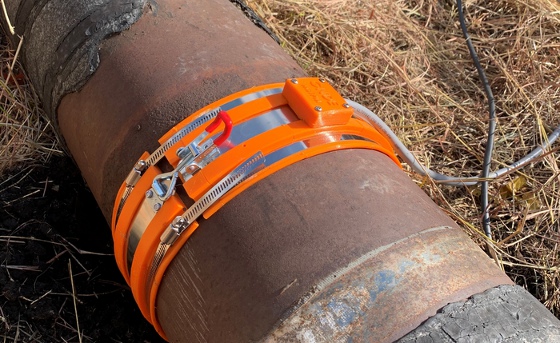 |
| November 15, 2022 | Volume 18 Issue 43 |
Designfax weekly eMagazine
Archives
Partners
Manufacturing Center
Product Spotlight
Modern Applications News
Metalworking Ideas For
Today's Job Shops
Tooling and Production
Strategies for large
metalworking plants
SwRI improves technology that detects leaks in pipes before they occur
Scientists at the Southwest Research Institute (SwRI) have created the next generation of transducers that use ultrasonic guided wave technology to detect anomalies in pipes, providing users with better tools to prevent leaks before they start. The device utilizes the SwRI-developed Magnetostrictive Sensor (MsS) technology.
"Pipeline corrosion resulting in leaks is very common," said SwRI staff engineer Sergey Vinogradov, who developed the technology with staff engineer Keith Bartels and other SwRI staff members. "There are only a few current methods to detect defects before they cause leaks. Quite often, the pipe is repaired and re-inspected after a leak occurs. We've developed a technology that can consistently monitor the pipe's condition, hopefully preventing leaks from happening in the first place."

SwRI has improved the transducers that use ultrasonic guided wave technology to detect anomalies in pipes, enabling users to prevent leaks before they start. [Credit: Photo courtesy of Southwest Research Institute]
The technology is known as a Magnetostrictive Transducer (MsT) Collar. It was originally developed by SwRI in 2002. The updated version has a flat, thin design, allowing it to be used on pipes in tight spaces. In custom configurations, it can withstand heat up to 400 F.
The new, segmented MsT design also features eight sensors that give the transducer the ability to identify the location(s) of pipe corrosion more accurately.
The MsT Collar uses magnetostrictive sensors, which generate and receive guided waves that propagate along an elongated structure, guided by its boundaries. This technique allows the waves to travel long distances with little loss in energy. In some cases, hundreds of meters can be inspected from a single location, though obstacles such as couplings would require an additional sensor.
"Instead of using one sensor to cover an entire pipe circumference, allowing only the axial location of an anomaly to be measured, we now have eight sensors in the transducer," Vinogradov said. "Each of the sensors are independently connected to the electronics so that all possible guided wave signals can be acquired. Algorithms combine this information to better detect and locate the anomaly both axially and circumferentially, and the growth of the corrosion can be monitored by examining data sets acquired over time."
The MsS system can send data to a remote terminal via a wireless transmitter unit or by means of a wired connection. It is designed primarily for oil and gas transmission pipelines to prevent costly and damaging leaks before they begin. However, the technology is versatile and has been used for other industrial pipes such as those used for water, heating, or in chemical plants.
Recently, Vinogradov and Bartels demonstrated the MsT Collar at the ASNT Annual Conference in Nashville, TN, from Oct. 31 to Nov. 3.
SwRI's Nondestructive Evaluation and Sensor Systems Section develops tools and techniques for nondestructive inspection, evaluation, and testing featuring guided waves, computed tomography, ultrasonics, electromagnetics, and other techniques.
Learn more at swri.org/industries/sensor-systems-nondestructive-evaluation-nde.
Source: Southwest Research Institute
Published November 2022
Rate this article
View our terms of use and privacy policy
